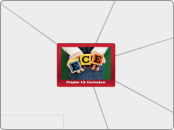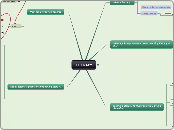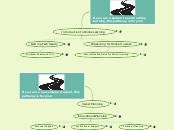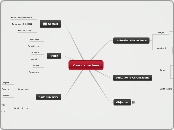The Roots of Early Childhood Curriculum
Developmentally Appropriate Practice
in the mid-1980s, early childhood educators (through NAEYC) published a position statement on developmentally appropriate practice
backlash to this movement claimed that it lacked academic rigot, and today's ECE climate has been molded by the demands of NCLB and standardized testing
early childhood teachers responded to the publication with a movement to focus curriculum on the needs and interests of children
Programs for Children at Risk
Head Start, a federally funded program, developed because so many poor children did not have successful school experiences
Head Start curriculum was based on the same principles and views as the psychoanalytic nursery school
results of the research were never definitive because there was too mauch transition of the families, and because each had such different educational goals
there were immediate benefits but gains started to dissipate after a few years; as a result several different curricula were tested in an attempt to find the most effective
Two European Programs
at the same time that progressive education and the kindergarten developed in the United States, Waldorf education and Montessori method developed in Europe
another European approach developed in the 1940s in Reggio Emilia, Italy
Maria Montessori developed a method based on children's inherent desire to explore and understand
Montessori's approach uses carefully designed and sequenced learning materials, learning experiences that actively involve the child, and the teacher's use of observation and guiding, rather than direct instruction
Montessori's biggest contributions to today's ECE landscape: the use of sensory materials and the design of a child-sized learning environment
Waldorf education developed in Germany by Rudolf Steiner, who was interested in the intersection of science and spirituality
Waldorf schools stress development of the child's body, mind, and spirit
his philosophy emaphsized balanced development, imagination, and creative gifts
The Nursery School
the growth of nursery schools followed a similar trajectory of conflict to the kindergarten programs
other nursery school educators used psychoanalytic theory as the foundation of their curricula
encouraged self-expression through free play, art, music, and dance
some nursery schools in the 1920s and '30s based curricula on ideas of John B. Watson, a behaviorist
focused on teaching children proper habits (such as hand washing, dressing, and eating)
The Kindergarten
most debate over curriculum revolved around th eissue of school readiness: if children were given freedom and encouraged to play would they be ready for first grade?
Froebel's followers were challenged by Patty Smith Hill and the American progressive education movement
Hill argued for more purposefuly activities and encouraging problem solving rather than rigid adherence to prescribed structure
John Dewey, the most prominent member of the progressive education movement, emphasized greater fredom and spontaneity in play, and involved the social life in the classroom
originally established in America following the design of F. Froebel, a program considered didactic in contrast with today's ECE programs
Background: curriculum evolves as society and its views/knowledge change
concept of the "educational pendulum" that alternates between emphasis on the learner and emphasis on the subject matter
the founders of ECE were inspired by respect for children, belief in the value of play, and vision of education as helping children become self-directed and creative
Chapter 10: Curriculum
How Should Early Childhood Curriculum Content Be Selected and Organized?
Similarities and Differences Among Integrated Approaches
similarities: much in common
require a skilled and engaged teacher
integrate some, if not all, curriculum subject areas
play and hands-on learning as core teaching strategies
investigation of topics that are of interest to children
all evolve from progressive education roots
differences: small and specific
the extent to which the learning environment and daily program are devoted to study of a topic
the degree of the teacher's direction
the extent to which the topic and initial questions for investigation are drawn from the children
The Project Approach
an American Interpretation of Reggio Emilia: focus on in-depth investigation of a topic
the goal is not to cover predetermined content, but help children develop skills for investigating a topic of interest
completing the engaging project requires research to answer a question, and continues until it is completed
Reggio Emilia Approach
integrated studies (projects) grow out of teachers' observations of and dialogues with children, the community, and families
children are encouraged to represent the study topics through many "natural languages"
teachers consider themselves children's partners in learning
Emergent Curriculum
child-centered approach that involves integrated studies
concerns: children's intersts may not provide sufficient material for meaningful study, or that the subject of children's interests may exceed the teacher's capabilities or resources
plans are changed as children's interests change
more child-directed: studies are chosen based on children's interests and understanding
The Developmental Interaction, or Bank Street, Approach
primary criticism: DIA is very demanding of teachers
comes from progressive education as described by John Dewey
however, more emphasis on providing real-world experiences, and children are given multiple opportunities to construct their knowledge through creativity
similar to unit/thematic approach, DIA involves integrated study of a topic selected by the teacher
The Unit, or Thematic Approach
this approach is referred to as "traditional": topics or "themes" are selected by the teacher as the organizing principle for a series of sustained activities
criticisms include: topics may be chosen without regard to interests and abilities of the children; often topics are only superficially explored; they may not provide enough direct experience
A related problem is that teachers may not choose activities that extend the children's understanding
What is the Future of Early Childhood Curriculum?
the importance of ECE has been recognized by policy makers
the need for recruiting and training teachers who:
know, understand, and use standards
expertly teach emerging literacy and math
understand curriculum and take it seriously
observe individuals
understand child development and how children learn
the challenge is to provide interesting and meaningful integrated curriculum while helping children to acquire the skills that will enable them to function in later schooling
The Purposes of Early Childhood Curriculum
4. Creating a more just and equal society.
grows out of values of progressive education, with a focus on remedying injustices
based in deeply held values and bellief in education to remedy injustice
curriculum focus on social issues, such as the Anti-Bias curriculum
3. Preparation for participation in a democratic society.
associated with progressive educators who embrace the philosophy of John Dewey; also most closely asigned to the constructivist developmental theories
focus on developing problem-solving skills, creativity, and becoming lifelong learners
designed to help children become intellectually engaged and socially actived
2. Efficient acquisition of knowledge and skills that are deemed important and that lead to success in future schooling in society.
this goal is associated with behaviorist theory
often associated with education of poor and minority communities
concerned with specific learning outcomes and identifying behaviors that can be observed and assessed
1. Preserving cultural values and insights from great works and disciplines of knowledge.
educators who promote this goal of education are called "traditionalists"
they believe in a cannon of the classics, and the importance of probing great ideas: truth, beauty, goodness, liberty, equality, justice
Two Theories of Development and their Implicaitons for Curriculum
Issues Relating to Behaviorist and Constructivist Approaches
some ECE programs attempt to bridge the gap between these two theories, attempting to combine focused curriculum and direct instruction with more child-centered developmentally appropriate curricula
constructivists maintain that direct instruction ignores what we know about how children learn, teaching content that is out of context and therefore meaningess
they argue that when teaching content is joyless and meaningless it destroys children's innate motivation
behaviorists do not believe that constructivist approaches provide children with the necessary background, especially in literacy and numeracy
some believe that child-centered, play-based curriculum may be suitable for children from affluent families but is not adequate for at risk children, who need an academic boost
Constructivist Theory
unlike teachers of older children, most EC educators today hold a constructivist view: that children construct understanding over time through reflecting on their interactions with people and the environment
most ECE programs today are informed by constructivist theory
curriculum informed by constructivist theory is called child-centered, developmentally appropriate, or informal
child-centered curriculum fosters development of the whole child and encouraged curiosity, with the underlying belief that children are active self-motivated learners
content emerges from children's interests and responds to their changing needs
learning through play is an important part of child-centered curriculum
Jean Piaget and Lev Vygotsky contributed to constructivist theory
Behaviorist Theory
curriculum based on behaviorist theory is referred to as academic, direction instruction, traditional and "instructivist" to suggest that learning depends on the aduls' direct instruction in academic content
test results are used to demonstrate the success of this program (it's important to note that these tests only assess the content taught in these programs)
simple fine motor skills and appropriate school behaviors are emphasized, but these behaviors are not learned through play
extrenal rewards and used to reinforce desired behaviors
curriculum that follows this philosophy tends to focus on academic subjects reading and math, with limited array of concepts
children are taught through direct instruction, and the same methods are used for all children
founded by Watson and Skinner, behaviorists believe that mechanisms of learning are the same for people of all ages and that behavior is controlled by the encironment and can be modified by applying the principles of conditioning
in application to education, behavioral conditioning takes the form of external rewards
What is Curriculum for Young Children?
areas of difference between elementary/older education and ECE:
methods for presenting the curriculum: in ECE children learn through hands-on exploration, guided learning and play
"teaching the whole child": all aspects of children's development (physical, social, emotional, cognitive) should be addressed in the curriculum
in ECE the term "curriculum" means:
everything the children experience in the program, planned or unplanned ("curriculum is what happens")
a particular model/philosophy that guides the entire program (for example: Montessori curriculum)
activities and lessons planned for the children's development









